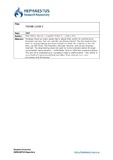| dc.contributor.author | Makridakis, Spyros | |
| dc.contributor.author | Hogarth, Robin M. | |
| dc.contributor.author | Gaba, Anil | |
| dc.date.accessioned | 2015-12-08T11:53:25Z | |
| dc.date.available | 2015-12-08T11:53:25Z | |
| dc.date.issued | 2009 | |
| dc.identifier.uri | http://hdl.handle.net/11728/6389 | |
| dc.description.abstract | Strategy theories make great claims about their ability to contribute to business success, but how realistic are those claims? We only have to look back to re engineering and its promised miracles, for a lesson in how far they can fall short. The founders, Michael Hammer and James Champy, claimed: “Re engineering does not seek to make business better through incremental improvements – 10% faster here or 20% less expensive there. The aim of re engineering is a quantum leap in performance – the 100% or even tenfold improvement that can follow from entirely new work processes and structures.” | en_UK |
| dc.language.iso | en | en_UK |
| dc.relation.ispartofseries | Strategy Magazine;Issue 21 | |
| dc.rights.uri | http://creativecommons.org/licenses/by-nc-nd/4.0/ | en_UK |
| dc.subject | Strategy theories | en_UK |
| dc.subject | Business success | en_UK |
| dc.title | Think lucky | en_UK |
| dc.type | Article | en_UK |


